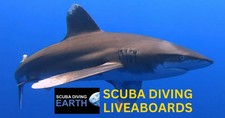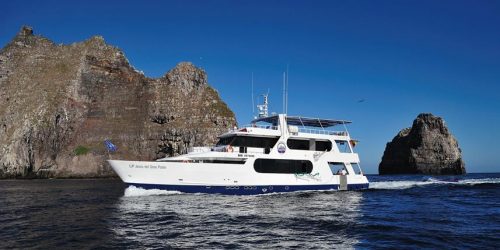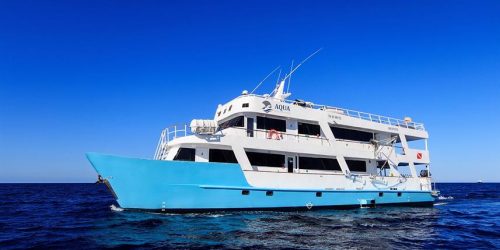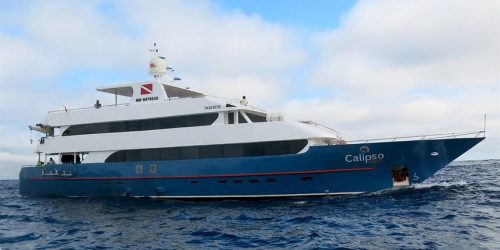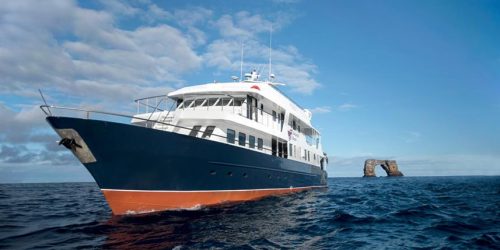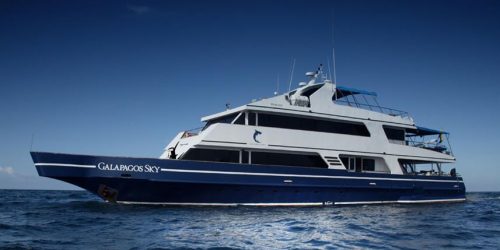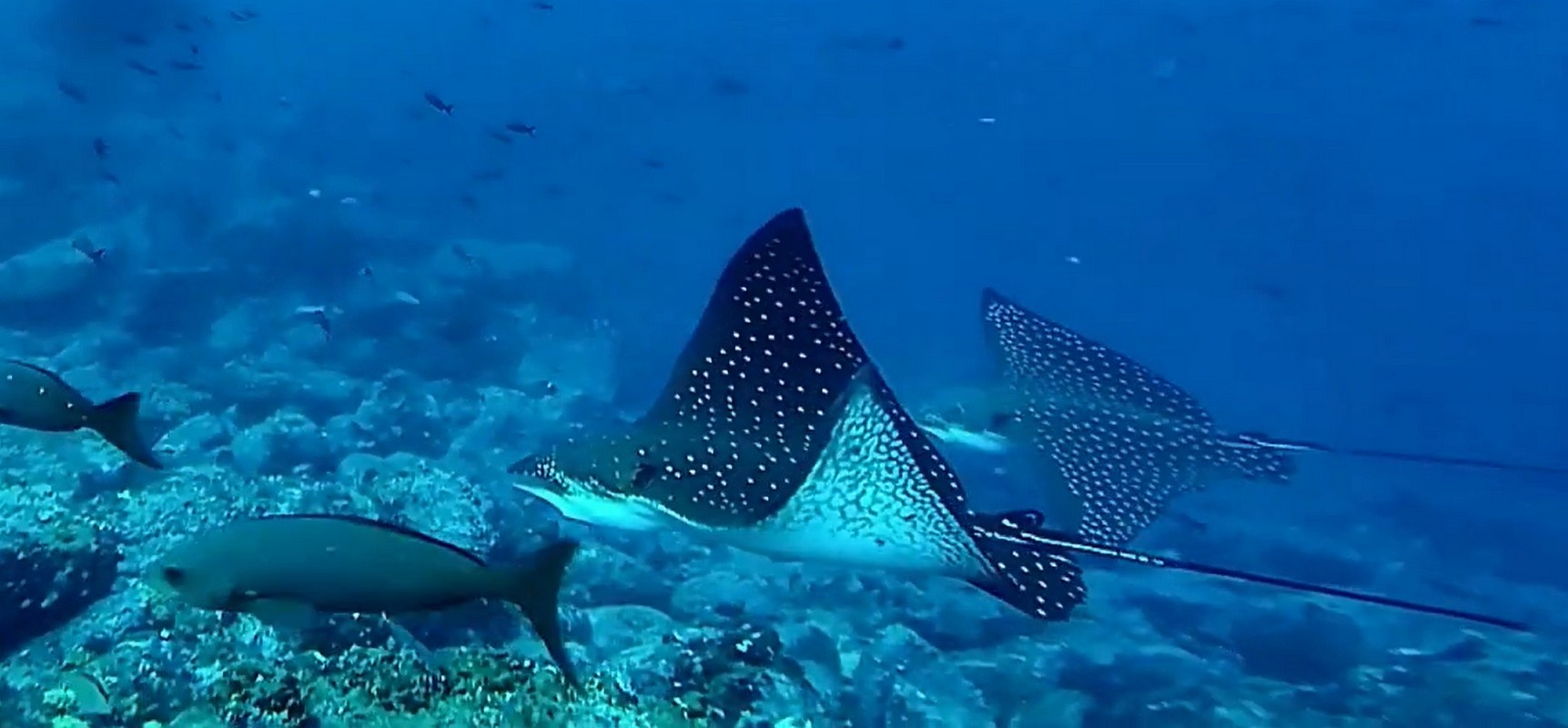
Wolf Island Liveaboard Diving
Remote Liveaboard Diving With Eagle Rays, Hammerheads, Galapagos Sharks And Sea Lions
Popular Wolf Island Liveaboards
MV Humboldt Explorer; Liveaboard diving in Galapagos; 8.9 out of 10 and is rated 'Fabulous'; from £489, $597, €557/day. Customer Review: Humboldt ExplorerSchools of hammerheads but also the pods of thousands of dolphins at Wolf and Darwin. The marine life was amazing We also saw Killer whales and the crew did everything to get us out on the pangas to get the best experience My partner was a non diver and was snorkelling with hammerhead, Galapagos and silkie sharks as well as the sea lions, again big thanks to the crew.
|
|
MV Galapagos Aggressor III; Liveaboard diving in Galapagos; 9.1 out of 10 and is rated 'Superb'; from £580, $708, €661/day. Customer Review: ”Simply the Best! sharks, sharks and sharks mantas land tours food crew it was just ALL delightful highly recommend!!!!! would do this trip again, and plan to…” Recommended for: whale sharks, hammerhead sharks, galapagos sharks. |
|
MY Aqua; Liveaboard diving in Galapagos; 9 out of 10 and is rated 'Superb'; from £457, $558, €521/day. Customer Review: ”Amazing trip! Didn’t want to leave. I had an amazing time aboard the Aqua. From the moment I met with the crew, everything was a breeze. I didn’t need to worry about anything during the duration of the trip. The days and schedule were organized so well. The staff took care of everything so all we really needed to worry about was waking up on time :).” Recommended for: Boat, crew, ease of everything. |
|
MV Calipso; Liveaboard diving in Galapagos; 9.4 out of 10 and is rated 'Superb'; from £658, $803, €750/day. Customer Review: ”Awesome trip in the best liveaboard I’ve been. One day at Darwin, while being surrounded of hammerheads and galapagos sharks as usual, a group of silky sharks decided to surround us feeling curious, we were so excited to have such an experience, when a massive Whale Shark appeared from the deep blowing our minds. Believe what they tell you about the Galapagos, and if you go with this really big and comfortable boat full of details with a crew that enjoys their job, you will be in the perfect hands. (I’ve been in 3 other liveaboards around the world, so I can compare, this one was the best). Recommended for: Sharks, staff and food. |
|
MV Galapagos Master; Liveaboard diving in Galapagos; 8.6 out of 10 and is rated 'Fabulous'; from £459, $560, €523/day. Customer Review: ”Galapagos is the best diving experience ever. Diving at Darwin and Wolf islands with hundreds of hammerhead sharks on each dive. Diving at ”Manta City” with lots of mantas.” Recommended for: The diving sites were the best experience ever. The dive guides are very skilled and know the sites well. All crew members makes the trip unforgettable. |
|
MV Galapagos Sky; Liveaboard diving in Galapagos; 9.5 out of 10 and is rated 'Exceptional'; from £708, $864, €807/day. Customer Review: ”Amazing experience. Our experience with Galapagos sky was amazing (even though we have very high standards!). The crew was perfect, always at the right place at the right time to help – pulling your wetsuit to get it off, giving you a hot chocolate as soon as you’re back on board, pushing you in the hot shower when you’re freezing cold, giving you a hot towel… All the organisation and the catering were perfectly orchestrated all along the way. Land excursions were nice additions to the diving itinerary. The cabin in the lower deck were functional and spacious enough without being too luxurious. In a week we saw a pregnant whale shark, loads of schooling hammerheads, Galapagos sharks, silky sharks, white tips, marble rays, marine iguanas, incredible schools of big eye jacks…. everything we were looking for was there! One thing we noticed is that almost half the divers had already been diving with the same boat and were coming back for more… it says it all. Thanks teams!!!” Recommended for: Best marine life in the world; Incredible crew always here for us; Great boat super functional and convenient; |
TO SEE ALL GALAPAGOS WOLF ISLAND LIVEABOARDS SCROLL TO THE TABLE BELOW
Liveaboard Diving At Wolf Island
Galapagos Wolf Island is only accessible by liveaboard dive boat as it’s 260km (163m) from Baltra Island and an overnight trip. The nutrient-rich currents off Wolf Island brings schools of hammerheads and Galapagos sharks, sea lions and whale sharks and provides some of the best diving in the world.
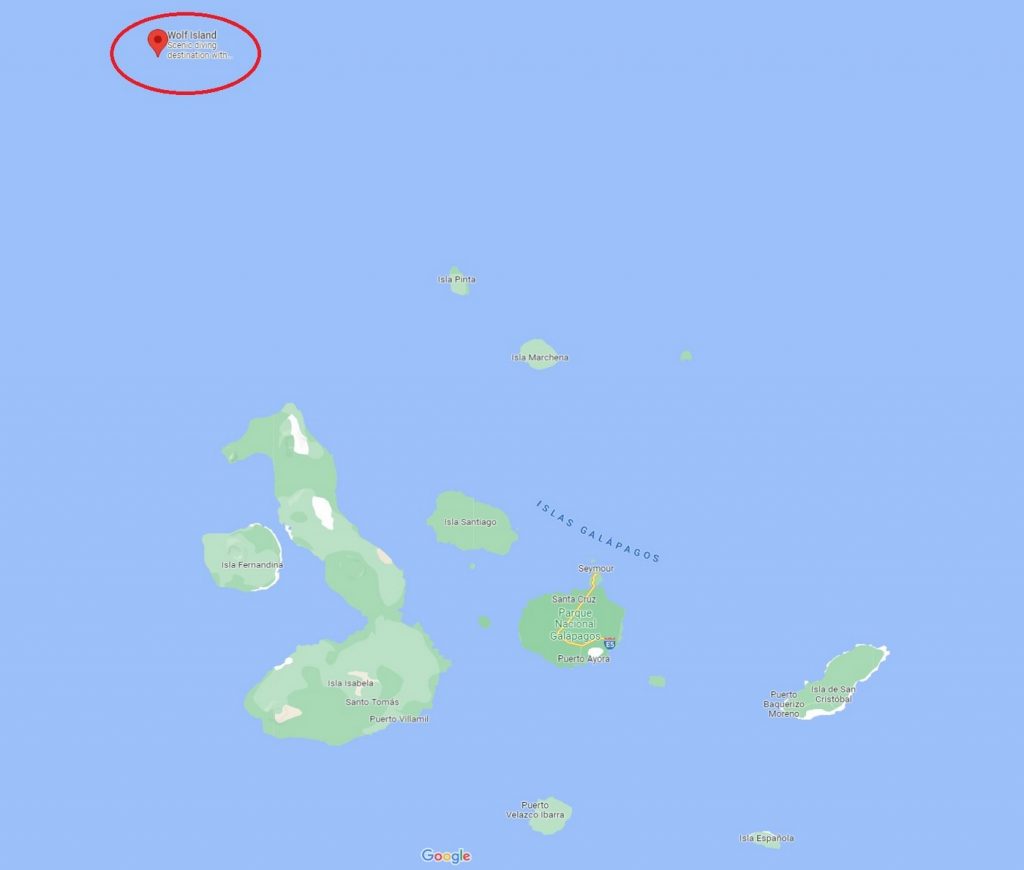
Wolf Island Galapagos Diving
Liveaboard diving is the only way to dive Wolf Island. Divers on liveaboards to Wolf Island experience some of the best diving in the world at this protected marine park. Wolf Island is a remote island about 260 kilometres (163 miles) from Baltra Island, or about 370 kilometres (230 miles) from San Cristobal Island, and about 150 kilometres (94 miles) off the most northerly point of Isabela Island, which is why it’s an overnight cruise on a liveaboard.
Wolf Island is home to the famous schooling hammerheads, which are at their highest density in January each year. The most popular dive site at Wolf Island is “El Derrumbe” which is on the southern east side of Wolf island.
El Derrumbe is a landslide and a boulder strewn reef where divers sit on the edge and watch schooling hammerheads, Galapagos sharks and the occasional whale shark swim past.
Ecuador created a marine sanctuary around Darwin and Wolf Islands in 2016 which covers 38,850 square kilometres (15,000 square miles). This marine sanctuary is off limits to all fishing, and is one of the key reasons why the sharks congregate around Wolf Island like they do.
What Marine Life Will You See At Wolf Island?
The marine life seen at Wolf Island include hundreds of schooling scalloped hammerheads, Galapagos sharks, silky sharks, tiger sharks, eagle rays, sea lions, marble rays, grouper, snapper, Almaco jack, wahoo, dolphins, large schools of pelagic fish including Pacific creole-fish, turtles, whale sharks and maybe manta rays.
The whale sharks arrive when the Humboldt Current is at its strongest, which is June to November.
Darwin and Wolf Island diving with hammerhead sharks
Table of Wolf Island Liveaboards
This list of Wolf Island liveaboards is in descending customer rating order, so the liveaboards with the highest customer rating will be at the top of the list. To filter this table for the features that are important for your Wolf Island liveaboard trip, select from the list of filters below.
| Discover Liveaboard | Customer Reviews | Price Per Day | |
|---|---|---|---|
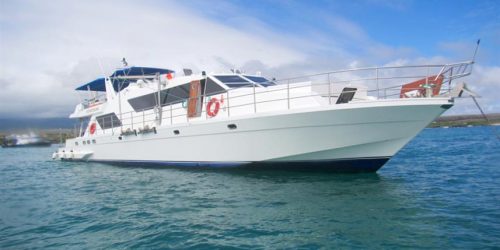 |
Review: MV Nortada; Book: MV Nortada | 8.3 Very good | from £350; $427; €399 |
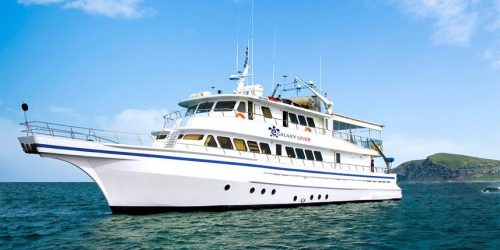 |
Review: MV Galaxy Diver; Book: MV Galaxy Diver | 0 Not rated | from £221; $270; €252 |
- 1
- 2
Note: The above “Price Per Day” was correct at the time of producing this article, as was the exchange rate used to convert the GBP cost to US Dollars and Euros. For an up-to-date cost for your chosen liveaboard, please visit the “Book” link above.
The Galapagos Wolf Diving Know Before You Go
The following are answers to “Know Before You Go” questions about the Wolf Island liveaboard diving, Galapagos.
How Do You Get To Wolf Island Galapagos?
Wolf Island is only accessible to visitors by travelling on a scuba diving liveaboard, as the island is remote and involves an over-night cruise to get there. Wolf is about 260k (163m) from Baltra Island, or 370k (230m) from San Cristobal Island, and 150k (94m) from the north point of Isla Isabela.
Can Beginners Dive Galapagos Wolf Island?
Beginner divers can dive in Galapagos, but they cannot dive the best dive sites like Darwin and Wolf Islands where most of the spectacular marine life is found, including schooling hammerheads and Galapagos sharks. You need a PADI Open Water certificate or equivalent as a minimum to dive here.
What Is The Best Time To Dive Wolf Island Galapagos?
The best time to dive in Galapagos for the most schooling hammerheads is January to April, and for whale sharks is between June and December. For more information please read this article: When is The Best Time to See Hammerheads in Galapagos Islands.
Is Diving In Galapagos Cold?
The sea temperatures around Galapagos can get cold, which can be as low as 21°C (69.8°F), so you may need a 5-7mm wetsuit when it’s this cold and maybe even a drysuit if you’re particularly sensitive to the cold.
Should You Bring a Wetsuit To Dive Wolf Island Galapagos?
You will need a wetsuit to dive Galapagos and Wolf Island, as water temperatures range between 16-30°C (60.8-86°F), but there are cold 16-18°C (60.8-65°F) thermoclines, so a thick wetsuit is needed year-round. You will need a 5-7mm wetsuit, or better still a drysuit, to dive Wolf Island.
It is also recommended to bring a hood and gloves when you dive Galapagos Wolf Island, to keep you warm and the gloves will protect your hands when grabbing hold of rocks to avoid being washed away in the currents.
The park laws of the Galapagos Islands National Park and Marine Reserve do not permit reef hooks to be used, which is why you will need to use your hands.
The park rules also forbid spear fishing, feeding the fish, collecting any souvenirs like shells and underwater scooters or DPV units.
For a guide about wetsuits and water temperature, please read this article: Wetsuit Temperature Guide Scuba Diving.
How Hard Is Diving Galapagos Wolf Island?
Galapagos Wolf Island diving can be hard as there are strong to moderate currents to contend with, which may require you to hold on to rocks so you do not drift away in the current. There are also surges that can cause difficulties during your safety stop, plus the sea state can be choppy too.
Will You Suffer Sea Sickness On Wolf Island Liveaboard?
If you suffer from motion sickness, you may get seasick on the liveaboard trip to Wolf Island due to the currents and surges in the region, which means conditions can be rough on the surface at Wolf Island.
How Long is The Trip To Wolf Island?
The trip to Wolf Island on a Galapagos liveaboard takes around 14-15 hours, and is an overnight cruise. The time it takes may vary, and the trip time depends on the departure starting point, which is usually the last dive site before starting the sail, and on weather conditions and sea state.
I hope you enjoyed this page about Wolf Island liveaboard diving
I’d love to hear from you. Tell us about your adventures of diving and snorkeling, in the comments below. Please also share your photos. Either from your underwater cameras or videos from your waterproof Gopro’s!
If this article hasn’t answered all of your questions. If you have more questions either about snorkeling or scuba diving (or specifically about Wolf Island liveaboard diving), please comment below with your questions.
There will also be many more articles about scuba diving (and snorkeling) for you to read and learn about these fabulous sports.
Have fun and be safe!
Select Another Liveaboard Location
| All Liveaboard Locations |
| Specific Liveaboard Locations |
